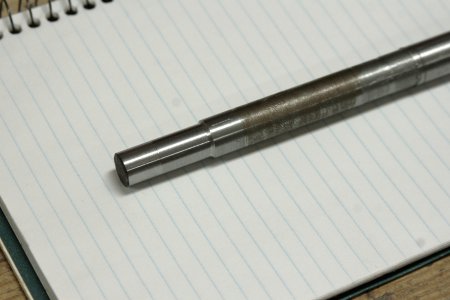Semi new machinist, picked up a new Smithy 12x37 (usual 12x clone) and have been seeing what I could do with it. Had a piece of 3/4" steel, probably CRS that I was using to see how fine a finish I could get with sharp carbide and HSS, both 1/2". I basically was making cuts and checking the finish at various depths and speeds. When I went for fine cuts I noticed a "banding" effect. These bands were spaced about 1/8" apart circumstantially around the part, about 1/16" wide and darker than the areas next to them, basically like stripes.
I was using 700 RPM for the HSS and up to 1250 for the carbide at the slowest longitudinal feed rate into the chuck. To get the fine cuts I set the compound at 5 degrees and advanced it rather than the cross slide. My math told me doing it that way gave me 0.0000174" per .001" of compound advance. I tried the same thing on my 6 x 19 3 in 1 with the same bits and approx the same speeds and feeds and didn't see them.
I made sure the gears were well meshed, tightened the drive belts, tightened the drag on the cross slide and saddle, and tried again using the tailstock. Helped a little. Funny thing is that the banding doesn't seem to be speed sensitive but I need to recheck that.
Using the fingernail roughness check, i couldn't pick up the bands nor could I with a sharp scribe.
Using the technique above, I seemed to be able to take off 0.0002 without problem so I am happy about that. I am posting a picture below. Best I could do, hope you can see - you may have to download the pic and blow it up n a new tab. There are three turned areas. The one in the center is where the banding is. the others were turned at deeper cuts for comparison.
Can anyone give me any clues as to what is going on? A friend suggested stuck chips on the cutter point but these are very regular. Thanks for any help.
 Steve in Central TX
Steve in Central TX

I was using 700 RPM for the HSS and up to 1250 for the carbide at the slowest longitudinal feed rate into the chuck. To get the fine cuts I set the compound at 5 degrees and advanced it rather than the cross slide. My math told me doing it that way gave me 0.0000174" per .001" of compound advance. I tried the same thing on my 6 x 19 3 in 1 with the same bits and approx the same speeds and feeds and didn't see them.
I made sure the gears were well meshed, tightened the drive belts, tightened the drag on the cross slide and saddle, and tried again using the tailstock. Helped a little. Funny thing is that the banding doesn't seem to be speed sensitive but I need to recheck that.
Using the fingernail roughness check, i couldn't pick up the bands nor could I with a sharp scribe.
Using the technique above, I seemed to be able to take off 0.0002 without problem so I am happy about that. I am posting a picture below. Best I could do, hope you can see - you may have to download the pic and blow it up n a new tab. There are three turned areas. The one in the center is where the banding is. the others were turned at deeper cuts for comparison.
Can anyone give me any clues as to what is going on? A friend suggested stuck chips on the cutter point but these are very regular. Thanks for any help.
 Steve in Central TX
Steve in Central TX

